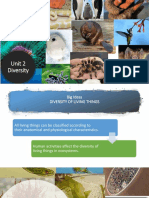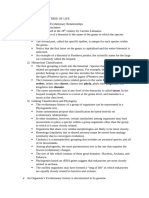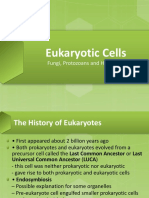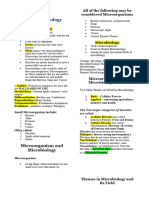Self-Study Guide Questions #1: Prokaryotes Eukaryotes
Self-Study Guide Questions #1: Prokaryotes Eukaryotes
Uploaded by
Daniel EsguerraCopyright:
Available Formats
Self-Study Guide Questions #1: Prokaryotes Eukaryotes
Self-Study Guide Questions #1: Prokaryotes Eukaryotes
Uploaded by
Daniel EsguerraOriginal Title
Copyright
Available Formats
Share this document
Did you find this document useful?
Is this content inappropriate?
Copyright:
Available Formats
Self-Study Guide Questions #1: Prokaryotes Eukaryotes
Self-Study Guide Questions #1: Prokaryotes Eukaryotes
Uploaded by
Daniel EsguerraCopyright:
Available Formats
Self-study guide questions #1
1. Why do you study microbiology?
The study of microbiology is done primarily to gain an understanding of the unique
properties and capabilities that microorganisms possess, therefore furthering our knowledge
with regards to the inner workings of a cell. The knowledge gained from these studies allow
us to advance in numerous important fields such as medicine, agriculture, the maintenance
of our environment, and biotechnology. With recent events, the study has been increasingly
crucial with the global effort to resolve the COVID-19 pandemic, especially as the pathogen
responsible for COVID-19 is the SARS-CoV-2 virus.
2. Tabulate the differences between prokaryotes and eukaryotes
Prokaryotes Eukaryotes
Genetic material not enclosed by Genetic material enclosed by nuclear
nuclear membrane (has nucleoid membrane (has a true nucleus)
region)
Lack membrane-bound organelles Has membrane-bound organelles that
perform more complex processes
Usually unicellular Usually multicellular
Cell division is done via binary fission Cell division is done via mitosis and
with some gene exchange via meiosis
conjugation
Has 70S ribosomes (small) Has 80S ribosomes (large)
Usually has circular chromosomes of Has multiple linear chromosomes with
DNA and plasmids histones
Usually smaller (less than 1 to 5 Larger in size (10-100 micrometers)
micrometers)
3. What are the three domains of life and examples? Tabulate the differences among them.
Bacteria Archaea Eukarya
Usually single-celled Usually single-celled Has unicellular and
organisms organisms multicellular organisms
Most cell walls have Lack of peptidoglycan in cell Cell wall not always
structural peptidoglycan walls, have unique present, if present, usually
membrane lipids made of cellulose or chitin
Usually have a prokaryotic Usually have a prokaryotic Have a eukaryotic structure
structure structure (true nuclei and membrane-
bound organelles)
Abundant in all manners of Usually found in extreme Reproduce via mitosis &
environments, including environments and have meiosis rather than binary
within humans & animals unusual metabolic fission
(microbiome). characteristics.
Usually has a single circular Usually has a single circular Has multiple linear
chromosome chromosome chromosomes
Has ester linked lipids with Has ether linked lipids with Has ester linked lipids with
L-glycerol L-glycerol D-glycerol
Examples: Cyanobacteria Examples: methanogens, Examples: Algae,
(makes significant amounts thermophiles, halophiles protozoans, yeasts.
of O2), Mycoplasma and E.
coli
4. What are the different divisions and types of microbes? Describe fully each microbe under
each division and type.
Microbes may either be cellular or acellular in structure, and are microscopic in size. The
cellular microbes include the bacteria, archaea, protists, and fungi.
Bacteria are unicellular prokaryotes with no membrane-bound nucleus or organelles.
Archaea are distinguished from bacteria due to their lack of peptidoglycan in their cell
walls, unique membrane lipids and are found usually in extreme environments (high
temperatures, highly acidic environments, and salt concentrations).
Fungi, comprised of primarily heterotrophic, eukaryotic organisms, and include
unicellular yeasts and up to multicellular mushrooms and molds. They also form
symbiotic relationships with certain plants and bacteria (e.g. mycorrhizae in plants)
Protists are primarily unicellular eukaryotes include algae, protozoans, slime molds
and water molds. They are also usually larger than bacteria and archaea. Some are
autotrophs capable of photosynthesis, while others are heterotrophs which rely on
the absorption of dissolved materials and phagocytosis for nourishment.
On the other hand, acellular entities such as viruses, viroids, prions and satellites lack any
cellular parts. They are also typically infectious agents and are submicroscopic in size.
Viruses are typically composed of a protein capsule and nucleic acid. They are
typically extremely small, with some being 10,000 times smaller than a bacterium.
Viroids are the smallest infectious agents known and are composed of a short strand
of RNA with no protein capsule.
Satellites are made up of nucleic acid contained in a protein shell and require the aid
of helper viruses to replicate.
Prions are made up of misfolded proteins that can trigger normally folded proteins to
fold abnormally.
5. Enumerate the contribution of the following scientists:
a. Robert Hooke – credited with first drawings of microorganisms using a prototype
microscope, also coined the term “cell”.
b. Lazaro Spallanzani – proved microorganisms could be killed through heat, by boiling
broth in flasks.
c. Edward Jenner – used material from cowpox lesions to immunize people from
smallpox, which was effectively the first smallpox vaccine.
d. Ignaz Philipp Semmelweis – demonstrated that hygienic practices and the use of
disinfectants greatly contributed to their survival of women in childbirth.
e. Louis Pasteur – further disproved spontaneous generation and pioneered in
fermentation, pasteurization, and developed early vaccines such as those for chicken
cholera, anthrax, and a new rabies vaccine.
f. Ferdinand Julius Cohn – helped disprove spontaneous generation with the discovery
of heat-resistant bacteria, in conjunction with John Tyndall’s evidence for such
organisms. Also played a role in classification of bacteria based on morphology and
physiology.
g. Joseph Lister – developed a system of antiseptic surgery designed to prevent
microorganisms from entering wounds, using heat sterilization and phenol on
surgical dressings.
h. Heinrich Anton de Bary – researched the role of fungi and other agents in causing
plant diseases, particularly smut and rust fungi which caused cereal crop diseases
i. Robert Koch – formulated Koch’s postulates which are a set of criteria that proves
the relationship between a specific disease and a microorganism. First utilized this
on anthrax, and then onto tuberculosis.
j. Charles Louis Alphonse Laveran - discovered the parasitic protozoans as causative
agents for malaria and trypanosomiasis.
k. Martinus William Beijerinck - first proposed the term “virus” to refer to infectious
agents.
l. Sergei N. Winogradsky – pioneered the cycle-of-life concept, the discovery of certain
oxidizing soil bacteria, isolated free-living nitrogen-fixing bacteria, and developed the
Winogradsky column, which can culture a large diversity of microorganisms.
m. Chaim A. Weizmann - considered to be the father of industrial fermentation after
discovering how to use bacterial fermentation to produce large quantities of
substances.
n. Angelina & Walther Hesse - pioneered the use of agar as a new solid medium for the
culturing of microbes.
o. Oswald Theodore Avery - discovered that DNA was the necessary agent for the
transformation of heat-killed virulent pneumococci that they initially observed.
p. Frederick Griffith - showed the potential of the pathogen Streptococcus pneumoniae
to transform from one strain to another and determined that the material responsible
for this to be DNA.
q. Jane Hinton - co-developed the Mueller-Hinton agar with John Howard Mueller,
which is now used to test bacterial susceptibility to antibiotics.
r. Alexander Fleming - discovered and isolated penicillin, the world’s first widely
effective antibiotic.
s. William C. Frazier – played an important role in the growth of food microbiology and
authored Food Microbiology which extensively covers the subject matter.
t. Julius Richard Petri - invented the culture dish or Petri dish while working under
Robert Koch.
u. Rene Jules Dubos – pioneered research on the isolation of antibacterial substances
from soil microorganisms that were later developed into major antibiotics.
v. Edward Laurie Tatum – conducted the experiment which provided the initial evidence
for bacterial conjugation alongside Joshua Lederberg using E. coli.
w. Esther Miriam Lederberg - discovered the λ (lambda) bacteriophage, the transfer of
genes between bacteria via specialized transduction, and the bacterial fertility factor
F. She also developed the technique of replica plating.
x. Joshua Lederberg – provided the initial evidence for bacterial conjugation alongside
Edward Tatum, which was later further confirmed by Bernard Davis.
y. Peter Charles Doherty - known for his research on the immune system’s response
towards viruses which infect the body, particularly on how T cells recognize their
target antigens.
z. Bruce N. Ames - invented the Ames test which utilizes bacteria to test the
mutagenicity of compounds.
aa. Antonio Luna – conducted extensive research on the differential diagnosis and
ontogeny of Plasmodium in human blood and improved on Romanowsky’s staining
method for histopathological blood film diagnosis for malaria.
References:
Chung, K.T., & Liu, J.K. (2017). Pioneers in Microbiology. World Scientific.
Forman D. (1991). Ames, the Ames test, and the causes of cancer. BMJ (Clinical research ed.),
303(6800), 428–429. https://doi.org/10.1136/bmj.303.6800.428
Hesse, W. (1992). Walther and Angelina Hesse - Early Contributors to Bacteriology. ASM
News, 58(8), 425-428
Hirsch, J.G. & Moberg, C.L. (1989). René Jules Dubos. Washington D.C: National Academy of
Sciences.
London School of Hygiene & Tropical Medicine. (2020). Beyond the frieze.
https://www.lshtm.ac.uk/aboutus/introducing/history/behind-frieze
National Science Foundation. (2015, March 17). Pioneering women in STEM.
https://www.nsf.gov/discoveries/disc_summ.jsp?cntn_id=134386
Sauer M. (2016). Industrial production of acetone and butanol by fermentation-100 years later.
FEMS microbiology letters, 363(13), fnw134. https://doi.org/10.1093/femsle/fnw134
Talaro, K.P., & Chess, B. (2017). Foundations in Microbiology. New York, NY: McGraw-Hill
Education.
Vallejo, B. (2017). Antonio Luna, science and the emerging Filipino national identity. Diliman
Review, 61(1), 88-108.
Willey, J. M., Sherwood, L. M., & Woolverton, C. J. (2016). Prescott's Microbiology. New York,
NY: McGraw-Hill Education.
You might also like
- I, Coronavirus. Mother. Monster. Activist. by Bayo AkomolafeDocument64 pagesI, Coronavirus. Mother. Monster. Activist. by Bayo AkomolafeBayo Akomolafe100% (26)
- Ap Evolution Gizmo WriteupDocument2 pagesAp Evolution Gizmo Writeupapi-522349089No ratings yet
- Laboratory Test Report: Test Name Result Sars-Cov-2: E Gene: N Gene: RDRP GeneDocument1 pageLaboratory Test Report: Test Name Result Sars-Cov-2: E Gene: N Gene: RDRP GeneSURESH RavellaNo ratings yet
- Microbiology: An Introduction To MicrobiologyDocument34 pagesMicrobiology: An Introduction To MicrobiologyG GayathriBSC BTNo ratings yet
- An Overview of Microbiology: Dr. Thaigar Parumasivam Email: Thaigarp@usm - MyDocument26 pagesAn Overview of Microbiology: Dr. Thaigar Parumasivam Email: Thaigarp@usm - MyHuii Jiing WongNo ratings yet
- Microbiology 214 SummaryDocument112 pagesMicrobiology 214 SummarykhanyikkuneneNo ratings yet
- Introductiontomicrobiology 161031150638Document30 pagesIntroductiontomicrobiology 161031150638revathidadam55555No ratings yet
- Introduction To Microbiology 2024 2225Document31 pagesIntroduction To Microbiology 2024 2225arbachat123456No ratings yet
- Intro Micro CH 1Document8 pagesIntro Micro CH 1qwivy.comNo ratings yet
- Introduction To MicrobiologyDocument38 pagesIntroduction To MicrobiologyMusaddiq Heitor Aveiro 7No ratings yet
- 1 Lec HistoryDocument10 pages1 Lec Historycharizepascual110899No ratings yet
- 1 IntroDocument5 pages1 IntroJeanjayannseptoeman100% (1)
- MDR 1162 - 1 History and Themes of MicrobiologyDocument26 pagesMDR 1162 - 1 History and Themes of Microbiologyllenson0425No ratings yet
- BacteriaDocument81 pagesBacteriaRaquel IlayaNo ratings yet
- Definition, Scope and History of MicrobiologyDocument13 pagesDefinition, Scope and History of MicrobiologySakshiNo ratings yet
- Ch1 Introduction To Microbiology P1&P2Document63 pagesCh1 Introduction To Microbiology P1&P2essa sunnaNo ratings yet
- 1 The Science of MicrobiologyDocument35 pages1 The Science of Microbiologyanuja maliNo ratings yet
- JAN ELMER L. LABESORES - Laboratory Microorganism Lab #1Document5 pagesJAN ELMER L. LABESORES - Laboratory Microorganism Lab #1JAN ELMER L. LABESORESNo ratings yet
- 2021 - 2022 BIO 101 LECTURE NOTE by Temitope Fasunloye AJANIDocument20 pages2021 - 2022 BIO 101 LECTURE NOTE by Temitope Fasunloye AJANI9p7fcsxyxfNo ratings yet
- Prelims Micropara LecDocument14 pagesPrelims Micropara LecBSN1F- JACILDO, KUH KYLA C.No ratings yet
- Bacterial Structure 1Document30 pagesBacterial Structure 1محمد ناصرNo ratings yet
- Chapter 1 ReviewDocument6 pagesChapter 1 ReviewDung NguyenNo ratings yet
- IntroductionDocument59 pagesIntroductionsangkalpasubba8No ratings yet
- Unit 1Document14 pagesUnit 1Pratik PawarNo ratings yet
- The CellDocument3 pagesThe CellMary Ann FriasNo ratings yet
- Micro paraDocument4 pagesMicro paraReselle EspirituNo ratings yet
- المحاضرة الأولى ميكرو د. محمد رمضانDocument40 pagesالمحاضرة الأولى ميكرو د. محمد رمضانAlmoatazbellah AbdallahNo ratings yet
- Pro TistsDocument39 pagesPro TistsNermine AbedNo ratings yet
- MicroPara Prelims 2nd Sem FinalDocument29 pagesMicroPara Prelims 2nd Sem FinalIvan MaximusNo ratings yet
- Pedi (1) - 043059Document129 pagesPedi (1) - 043059Abas AhmedNo ratings yet
- Microbiology Handout-4Document47 pagesMicrobiology Handout-4cherishkathy123No ratings yet
- MCB 301 (Bacteria Diversity)Document9 pagesMCB 301 (Bacteria Diversity)Christopher EkwediNo ratings yet
- Phylogeny and The Tree of LifeDocument5 pagesPhylogeny and The Tree of LifeNanik ZubaidahNo ratings yet
- MicrobiologyDocument494 pagesMicrobiologyAditi ChaudharyNo ratings yet
- Introduction To Microbiology.Document36 pagesIntroduction To Microbiology.sohailshahani02No ratings yet
- MicrobiologyDocument675 pagesMicrobiologyzakarya alamamiNo ratings yet
- BingoDocument11 pagesBingoOsannah Irish InsongNo ratings yet
- An Introduction To MicrobiologyDocument25 pagesAn Introduction To MicrobiologyskweamiishNo ratings yet
- W1 PresentationDocument60 pagesW1 PresentationWaaqoo Guutuu Waaqoo GuutuuNo ratings yet
- PPT1.3 - Classification of MicroorganismDocument35 pagesPPT1.3 - Classification of MicroorganismBharath udayNo ratings yet
- Environmental Microbiology UNIT 1Document43 pagesEnvironmental Microbiology UNIT 1Esai Kanaga YadavNo ratings yet
- Eukaryotic Cells & Microorganisms - Aug2016Document42 pagesEukaryotic Cells & Microorganisms - Aug2016Karl Francis GarciaNo ratings yet
- SBT 2173: Introduction To Microbiology: Dr. Elizabeth Mitaki Lesson 1Document30 pagesSBT 2173: Introduction To Microbiology: Dr. Elizabeth Mitaki Lesson 1Derrick kinyaNo ratings yet
- Bot 111 Notes 2020-1Document7 pagesBot 111 Notes 2020-1ogbeideblessing9476No ratings yet
- Chapter 1Document19 pagesChapter 1Joshua QuimsonNo ratings yet
- Micbio Module 1 - 3.classification of MicroorganismsDocument19 pagesMicbio Module 1 - 3.classification of Microorganismsrakshithapatil2909No ratings yet
- Micro Part 1Document109 pagesMicro Part 1amena wajeehNo ratings yet
- CH 1 The History and ScopeDocument21 pagesCH 1 The History and ScopeBronwyn JuliusNo ratings yet
- Introduction To Microbiology: Department of Microbiology Medical Faculty USUDocument26 pagesIntroduction To Microbiology: Department of Microbiology Medical Faculty USUagnesNo ratings yet
- Chapter 1 Microbial WorldDocument16 pagesChapter 1 Microbial WorldSarojiniNo ratings yet
- Biological ClassificationDocument9 pagesBiological Classificationajeet.kr2105No ratings yet
- SEC 4 Classification of Microorganisms - PrelimDocument30 pagesSEC 4 Classification of Microorganisms - PrelimLyncell VillarNo ratings yet
- Micro 1st ProkaryotesDocument16 pagesMicro 1st ProkaryotesMatahari SempurnaNo ratings yet
- Biological ClassificationDocument15 pagesBiological ClassificationSanjeevNo ratings yet
- Lesson 5Document11 pagesLesson 5Blezhl Fe Lacre ReyesNo ratings yet
- Microbiology, S-WPS OfficeDocument10 pagesMicrobiology, S-WPS OfficejoanNo ratings yet
- The Microbial World & You: NomenclatureDocument9 pagesThe Microbial World & You: NomenclatureApryll DarlineNo ratings yet
- Groups of Microorganism - 062035Document4 pagesGroups of Microorganism - 062035ismailaabdulrasheed93No ratings yet
- An Invisible World: College PhysicsDocument39 pagesAn Invisible World: College PhysicsAngela DardonisNo ratings yet
- Evolution of Microorganisms: From Prescott's Microbiology Biology 2710 Professor W.D.WestDocument38 pagesEvolution of Microorganisms: From Prescott's Microbiology Biology 2710 Professor W.D.WestAmal IdreesNo ratings yet
- CH 10 ClassificationDocument42 pagesCH 10 ClassificationRediat GossayeNo ratings yet
- Medical Microbiology: Microbial Colonization May Result inDocument4 pagesMedical Microbiology: Microbial Colonization May Result inHossam HafezNo ratings yet
- The Antibiotic Alternative: The Natural Guide to Fighting Infection and Maintaining a Healthy Immune SystemFrom EverandThe Antibiotic Alternative: The Natural Guide to Fighting Infection and Maintaining a Healthy Immune SystemRating: 5 out of 5 stars5/5 (1)
- Staining Lab ReportDocument5 pagesStaining Lab ReportDaniel EsguerraNo ratings yet
- Systematics Lec Notes CH1Document5 pagesSystematics Lec Notes CH1Daniel EsguerraNo ratings yet
- Ophiomastix Annulosa: Specimen Habitat Mode of Nutrition Distinct Characteristics Parts and FunctionsDocument6 pagesOphiomastix Annulosa: Specimen Habitat Mode of Nutrition Distinct Characteristics Parts and FunctionsDaniel EsguerraNo ratings yet
- Theology - U1-2 - L1-5 - V1Document11 pagesTheology - U1-2 - L1-5 - V1Daniel EsguerraNo ratings yet
- Chapter 9: Architectural Pattern of An Animal 9.1 Hierarchical Organization of Animal ComplexityDocument43 pagesChapter 9: Architectural Pattern of An Animal 9.1 Hierarchical Organization of Animal ComplexityDaniel EsguerraNo ratings yet
- ROTAVIRUSDocument13 pagesROTAVIRUSAsma HossainNo ratings yet
- Soal UM Bahasa Inggris 2021Document9 pagesSoal UM Bahasa Inggris 2021Aliyah Al-IhsaniyahNo ratings yet
- Chemical Coordination and Control: Michael A. Tabug, Msc. Shs-InstructorDocument19 pagesChemical Coordination and Control: Michael A. Tabug, Msc. Shs-InstructorMike TabsNo ratings yet
- Unit 4 Human Health and DiseasesDocument12 pagesUnit 4 Human Health and DiseasesDashamiNo ratings yet
- Technical Specification - Dengue Test KitsDocument2 pagesTechnical Specification - Dengue Test KitsPharmastar Int'l Trading Corp.No ratings yet
- Immune System (Inn & Adapt)Document53 pagesImmune System (Inn & Adapt)Bushra Khan100% (1)
- Immune DisorderDocument37 pagesImmune DisorderJessica TieuNo ratings yet
- CDC Hiv Diagnostic Tests Loinc Map 2021Document18 pagesCDC Hiv Diagnostic Tests Loinc Map 2021maria putriNo ratings yet
- Bio HerbicidesDocument1 pageBio HerbicidesTUSHAR DASHNo ratings yet
- Template Book Chapter - 2021Document2 pagesTemplate Book Chapter - 2021Ana Dwi PrihatiningsihNo ratings yet
- LifePad Cartridge IFUDocument21 pagesLifePad Cartridge IFUGuneyden GuneydenNo ratings yet
- Abstract Linalool, Elemol, Geranyl Acetate Antiviral Activity Enveloped VirusesDocument2 pagesAbstract Linalool, Elemol, Geranyl Acetate Antiviral Activity Enveloped Virusesahmed jawadNo ratings yet
- Auburn University BIOL 5200 Final ReviewDocument18 pagesAuburn University BIOL 5200 Final ReviewClaudia Ann RutlandNo ratings yet
- Starkville Dispatch Eedition 7-26-20Document20 pagesStarkville Dispatch Eedition 7-26-20The DispatchNo ratings yet
- The Covid-19 Fraud & War On Humanity: DR Mark Bailey and DR John Bevan-SmithDocument46 pagesThe Covid-19 Fraud & War On Humanity: DR Mark Bailey and DR John Bevan-SmithAditya Ikhsan Prasiddha100% (2)
- Emropub 2015 en 1887Document18 pagesEmropub 2015 en 1887jamshaidjiNo ratings yet
- Surgical InfectionsDocument310 pagesSurgical InfectionsOmar Ed ChavezNo ratings yet
- Mono ArthritisDocument1 pageMono ArthritisPavithraNo ratings yet
- Epidemiology Characteristics of Streptococcus Pneumoniae From Children With Pneumonia in Shanghai: A Retrospective StudyDocument10 pagesEpidemiology Characteristics of Streptococcus Pneumoniae From Children With Pneumonia in Shanghai: A Retrospective StudyAna-Mihaela BalanuțaNo ratings yet
- Ventilator Associated Pneumonia (Vap) OkDocument23 pagesVentilator Associated Pneumonia (Vap) OkREVA NINGTIA SARINo ratings yet
- Microbiology and Parasitology 2ND Term PDFDocument15 pagesMicrobiology and Parasitology 2ND Term PDFRizalyn Padua ReyNo ratings yet
- Soal Bahasa Inggris XI-2 1920Document10 pagesSoal Bahasa Inggris XI-2 1920ameliaNo ratings yet
- Genetic Analysis and Mapping in Bacteria and BacteriophagesDocument45 pagesGenetic Analysis and Mapping in Bacteria and BacteriophagesVikas KatariaNo ratings yet
- CLED AgarDocument4 pagesCLED Agarsameera ruffaiNo ratings yet
- Introduction To Medical Microbiology 2023Document93 pagesIntroduction To Medical Microbiology 2023Samuel fikaduNo ratings yet
- CAPE Communication Studies 2015 P2 (Guyana)Document6 pagesCAPE Communication Studies 2015 P2 (Guyana)brit0% (1)
- Hlimkhawpui - 15.08.2021Document2 pagesHlimkhawpui - 15.08.2021JC LalthanfalaNo ratings yet






























































































